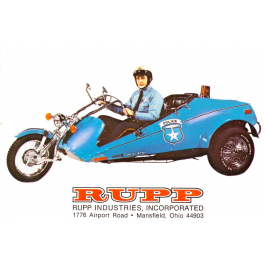|
|
Rupp CentaurDescriptionThe Rupp Centaur was only produced in 1974 and 1975, with the 1974 being a one seater and the 1975 being a two seater.Much of this information below came from the website OldRupps.com. This site is a great resource for Rupp owners. Rupp manufactured 1200 Centaurs in the two years of production, and one of its most famous owners is Elvis Presley. In fact, if you were to take a tour of Graceland, you would still find it in the Presley collection. If you were to find a Rupp Centaur today, I would suspect it to have low mileage. Encasing a snowmobile motor in a fiberglass body in a machine expected to run soley in warm months proved to be a problematic design and many Centaurs suffered mechanical breakdowns. Rupp Manufacturing, Inc. was founded in 1959 by Mickey Rupp, with 8 employees housed in a 3,000 sq. feet facility, in Mansfield, OH. During that first year, Rupp manufactured Dart Karts. In 1960, Rupp expanded their production to making mini-bikes. Rupp made 1,000 mini-bikes that first year. In 1964, Rupp created a few snowmobile prototypes, and by 1965, became a snowmobile manufacturer making 500 machines that year. By 1969, Rupp employed over 400 people in a 180,000 sq. feet facility, producing a multitude of recreational machines including mini-bikes, ATVs and go-karts, and five models of Sno-Sport snowmobiles. Later that year, Mickey Rupp ran 95.5 mph at West Yellowstone in a Sno-Sport drag sled featuring a 525 horsepower Ford racing engine. In 1970, Rupp sales topped $30 million and owner Mickey Rupp was honored as one of the "Outstanding Young Men of America." Rupp produced 35,000 snowmobiles that year. By 1971, Rupp employed 850 people, and featured a research center, administration building, all-purpose proving grounds, a styling building, and even had some automatic computerized operations. In addition, owner Mickey Rupp served as a director of the International Snowmobile Industry Association. In 1972, fueled by a soft market created by a couple of years of poor snow conditions, Rupp's profits dwindled and the company began to lose money. In 1973, Mickey Rupp was forced to sell the company which was facing bankruptcy. On April 1st, Rupp sold a controlling interest in the company to an investment group led by Joseph Hrudka. 1973 would also mark the end of the Rupp partnership with the Japanese engine manufacturer Tohatsu. In 1974, Rupp would make the design change to using Kohler powerplants in their snowmobiles. In 1974 and 1975 Rupp saw a decline in overall sales, likely due to rumors of the company going out of business, nagging quality control issues, and the transition period under new ownership of Hrudka from the extremely popular and company founder, Rupp. In 1976, Rupp seemed to be poised to make a major comeback with the introduction of snowmobiles with liquid cooled Xenoah powerplants. The 1976 liquid cooled Nitro model was tested by SnowSports magazine and "was the top performer or close to it in every speed run." Despite the popularity of the new models, Rupp continued to experience financial difficulty. In the Spring of 1977, the ownership of Rupp filed for bankruptcy and enlisted help from Arctic Cat. As a result of this partnership with Arctic Cat, snowmobile production was cut in half and down to just three models - a 295cc fan cooled Sport, and two liquid cooled Nitro models. Although Rupp designed, engineered, and marketed their 1977 line-up, the Rupps were actually produced and assembled by Arctic Cat. The 1977 Rupp 440 Nitro was heralded as one of the fasted tested muscle sleds by snowmobile magazines and featured an 80HP motor capable of attaining speeds in excess of 80MPH. By the Summer of 1977, the writing was on the wall and the 1978 model year would be the last for Rupp. Rupp Manufacturing, Inc. would go under in 1978, never to resurface again. Some of their popular snowmobiles include: Rupp Sno-Sport - Rupp's first sled, initially offered in 1966 and produced through the 1970 season. Rupp Sno-Sport sleds featured SACHS motors, an aluminum tunnel, 12 volt lighting, and a 4.5 gallon fuel tan. In 1969, Rupp offered five Sno-Sport models, a S-281 with a 285cc motor, a GT-300 with a 298cc motor, and a GT-370 with a 368cc motor along with a GTE-300 and GTE-370 - essentially the same machines with electric start. Rupp Nitro - This sport sled was initially offered in 1972 and was produced through Rupp's last year in 1978, with a one year hiatus in 1974. When first offered in 1972, buyers had a choice of 295cc, 340cc, 400cc, 440cc, and 650cc fan cooled Tohatsu powerplants, although the 650cc models were rumored to have been recalled. In 1975, buyers had a choice of the Nitro II, with fan cooled Kohler motors, or the popular Rupp Nitro F/A race sled, which featured 340cc or 440cc Kohler free air motors. In 1976 Rupp Nitros featured Xenoah motors with liquid cooling, offering 250cc, 340cc, and 440cc models. 1977 and 1978 brought few major changes to the Nitro, other than the addition of redesigned decals each year, the dropping of the 340cc model, a couple of motor enhancements, a handlebar pad in 1977, and a new dash design in 1978. Rupp Nitro II - The Nitro II was a whole new chassis and this model was offered in 1974 and 1975. The Nitro II shares very few parts with any other model (other than the Nitro F/A of 1975), and featured a choice of 340cc or 440cc Kohler fan cooled motors, CDI ignition, and a slide suspension. In 1975, the Nitro II was officially called a "Nitro" but other than decals was essentially the same as the 1974 model. Rupp American - One of Rupp's most popular models and a true family machine, the American was first offered in 1971 and produced through 1975. In 1971, the American was offered in just a 30HP model, but in 1972, the American featured electric start standard, a bogey suspension, and an 18" wide track, and was offered in 30HP, 40HP, or 50HP models. In 1973, the American had trimmed to offering 30HP and 40HP models only, with buyers having the choice of either manual or electric start as well as a choice of bogie or slider suspensions. The track width was trimmed also by a 1/2" in 1973 to 17 1/2." Americans remained largely unchanged from 1973 to 1975. Rupp Yankee - Another one of Rupp's most popular early models, the Yankee was also initially offered in 1972 and was produced again in 1973. The Yankee was a midline product, and offered a 15 1/2" track, manual start, and a bogey wheel suspension. Yankee's were offered in 25HP, 30HP, and 40HP models in 1972. In 1973, the 25HP model was dropped. Rupp Magnum - Rupp's racing snowmobile manufactured from 1970 to 1976 with a two year hiatus in 1974 and 1975. Prototypes and considerable testing led to the creation of the Magnum series of racing snowmobiles. In 1971, the Magnums were built in 400, 440, 600 and 800cc versions. The 400 Magnum had a narrow track while the the 600s and 800s had wide tracks. You could get the 440 in a wide or narrow track. Both the 600 and 800cc versions had wide tracks. By 1973, the Magnum line-up had been trimmed to one model, a 440 free air Tohatsu version featuring many lightweight components such as an aluminum fuel tank, aluminum motor plate, and aluminum skis, In 1976, the Rupp Magnum featured liquid cooling for the first time, a lightweight short chassis with a combination swing-link slider suspension, twin Mikuni carburetors, reed valves, wide stance aluminum skis, and a 4-band track. 1976 Magnums were available with 250cc, 340cc, and 440cc Xenoah powerplants. Rupp Sport - The popular Rupp entry level sled, was initially offered in 1973 replacing the Rouge model of 1972. Rupp Sports were produced through 1978. In 1973 through 1975, Rupp Sports consisted of two models, a 25HP and 30HP model with CDI ignition, bogey suspension, and a "racing wedge" style seat. In 1976, the Sport was offered in a new chassis (the previous Nitro II chassis) with a Xenoah 340cc fan cooled motor and CDI ignition. In 1977 and 1978, Sports remained essentially unchanged, but they had 295cc fan cooled Xenoah motors. Rupp Rally - Initially offered in 1972, the Rally replaced the 650cc Nitro using the same Nitro components combined with the American 440cc motor. The Rally made appearances again in 1976 and 1978, this time replacing the 1975 Nitro II, utilizing it's chassis and main components. Unlike the Nitro II's, which gave buyers a choice of a 440cc or 340cc fan cooled Kohler motor, the 1976 Rally was offered with just a 440cc Kohler fan cooled engine while the 1978 Rally only offered a 484cc Xenoah fan cooled motor. All of the Rally's featured CDI ignition, a slide suspension, tachometer, and a speedometer. Rupp Rogue - The Rouge was offered only one year, 1972, and represented the entry-level market for Rupp that year. The Rouge was offered in two models, the 15HP and 25HP. The Rouge would be replaced in 1973 by the Sport model. Some of their popular mini-bikes include: Rupp TT500- This was Rupp's first entry into the minibike market. Rupp Roadster-Rupp began production of the Roadster in 1969 and produced the Roadster again in 1970 with modest changes. The Roadster used a Tecumseh 172cc 4HP motor and had 10" wire wheels and drum brakes as well as headlights. In 1970, a person could get a Roadster in three colors - Rally Red, Grabber Orange, and Lightning Blue. Rupp Roadster2 - This bike offered a 4HP Tecumseh motor, 12" wire wheels, front and rear lights, and brakes in both the front and rear. The Roadster 2 was Rupp's top selling mini-bike in 1971. Rupp Scrambler- The Scrambler utilized a 150cc 3.5HP Tecumseh motor, 10" wire wheels, and a rear expanding drum brake. The scrambler did not have a headlight. The Scramblers were produced in 1970 and 1971. Rupp Black Widow- This was Rupp's performance minibike. It featured a 4 HP Tecumseh motor, performance Dell'Oroto carburetor, and wire wheels. Rupp Enduro- The Enduro, like the Roadster, featured 10" wire wheels, a 172cc Tecumseh 4 HP motor. The Enduro didn't have a headlight or taillight, and was designed for more off-road use. Rupp "Chopper"- This minibike was Rupp's price leader, with a 127cc motor, one speed clutch, and fixed foot pegs. The "Chopper" was only $129.00 MSRP in 1970. Rupp also produced a couple of ATVs, a four-wheeler called the Go-Jo and a 3 wheeler called a Rat Rupp also made a three wheeled tricycle called the Centaur, which was only produced in 1974 and 1975. The bodies were constructed of fiberglass and they were offered in four colors - red, white, blue, and yellow. Below is some price data from Harry Kraemer's Wheels & Wings site. Some sites list this as a Rupp Centaur and some as a Rupp Centuar. When doing our research, we have included both below. Detailed Information
Additional InformationAdditional Information
|



